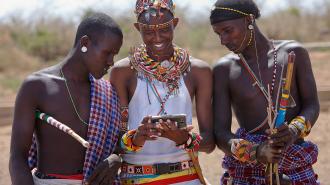2.6 billion people don’t use the internet. What’s stopping them?
And, more importantly, what’s being done to get them online?
This article is an installment of Future Explored, a weekly guide to world-changing technology. You can get stories like this one straight to your inbox every Saturday morning by subscribing here.
It’s 2035, and the entire world has access to the internet. This means everyone, finally, is able to further their education, access a huge range of jobs, easily start their own business, and find health information that could literally save lives. Here’s how we’ll do it.
The digital divide
In less than 35 years, we’ve gone from the internet being a fringe technology used by about 3 million people (roughly the population of Chicago) to being an indispensable part of modern life for billions.
So, what’s stopping the 2.6 billion people who still aren’t online from taking advantage of one of the most transformative inventions in all of human history? And, more importantly, how do we overcome those hurdles to ensure everyone, everywhere, is able to join the information superhighway?
To find out, let’s take a look at the history of internet connectivity, the challenges to getting everyone online, and how the oldest agency in the United Nations is working to overcome them.
Where we’ve been

Where we’re going (maybe)
A hundred years before ARPANET, the electric telegraph was the “next big thing” in communication, sending messages long distances far faster than trains and postmen on horseback.
Initially, each country had its own telegraph system, though, which caused problems when people tried to send messages across borders, so the International Telegraph Union was created to govern international telegraph networks in Europe.
That organization evolved into the International Telecommunication Union (ITU), the United Nations’ (UN) specialized agency for information and communication technologies.
Just like it helped overcome barriers to the adoption of telegraphs (and, later, telephones, radio, and television), the ITU is now working to close the digital divide by not only ensuring universal access to the internet, but also making sure everyone has the tools they need to take full advantage of it.
“Achieving universal and meaningful connectivity — the possibility for everyone to enjoy a safe, satisfying, enriching, productive and affordable online experience — is a top priority for ITU,” Dr. Cosmas Luckyson Zavazava, Director of the ITU’s Telecommunication Development Bureau, told Freethink.
Here’s how it’s working to reach that goal.
The coverage gap
The first step is ensuring that everyone can get online if they want to, and right now, 5% of the population lives in places that lack access to even mobile networks.
This is known as the “coverage gap,” and according to the ITU, almost everyone who falls on the side of it without internet access lives in a rural area or low-income nation.
This is mainly because building the infrastructure needed to connect people to the internet isn’t cheap or easy, especially in remote locations, and internet providers need to believe they’ll have enough customers in an area to make the investment worthwhile.
Not only do many rural or low-income areas not meet that requirement, but nations with unstable governments and hard-to-navigate regulations can further discourage internet providers from even trying to establish service there.

The ITU is facilitating collaboration between governments, internet providers, and other stakeholders through programs like the Partner2Connect (P2C) Digital Coalition.
Its goal is to convince groups to invest resources toward helping close the digital divide, and as of May 2024, it had secured more than 500 pledges worth an estimated $40 billion to increase access to the internet.
Chinese tech company ZTE Corporation, for example, has pledged to construct $400 million worth of information and communication tech (ICT) infrastructure annually in developing countries between 2023 and 2025. The nonprofit Internet Society, meanwhile, will build 100 complimentary community internet networks by 2025 through the P2C.
Other pledges aim to narrow the coverage gap with satellites, which can beam high-speed internet down to a receiver anywhere on Earth — satellite operator Intelsat, for example, has pledged to connect 100 schools in rural or remote areas to its satellite internet network by 2025 through the P2C program.
“In order to connect the unconnected, there is a need for a holistic approach considering all technologies, including fixed, mobile, and satellite technology, and network infrastructures for multiple telecommunication services and applications,” said Zavazava.
Usage gap
Coverage alone won’t end the digital divide, though. We also need to address the “usage gap,” the difference between the 95% of the population that has theoretical access to the internet and the 67% of people who are actually online.
Cost is a major reason for this gap — an entry-level mobile broadband subscription costs about 9% of the average income in a low-income nation, according to the ITU, a share 20 times greater than in high-income nations — but it isn’t the only reason.
Even if a person lives somewhere with affordable internet, they might not have access to the necessary hardware (smartphones, computers, reliable electricity, etc.), or they may lack the skills needed to take full advantage of the technology.

While some P2C partners are helping increase internet access, others are helping address the usage gap. UK charity unconnected.org, for example, is equipping schools in rural and underserved areas with free internet, while telecom provider IndoSat is providing free data packages and digital training to 100,000 people in Indonesia.
The ITU is working to close the usage gap through other initiatives, too, including the ITU Academy, which offers online training in cybersecurity, AI, the Internet of Things, and more, and the Digital Transformation Centres (DTC) initiative.
“Under the DTC Initiative, we have trained over 305,000 citizens in basic and intermediate digital skills in remote and underserved communities across regions over the past 4 years,” Zavazava told Freethink. “This has helped them improve their economic and social well-being and find new job opportunities.”

A “perpetual” digital divide
Perhaps the biggest challenge with addressing the digital divide is that technology is constantly evolving, and access to the latest tech is never evenly distributed.
“New technologies come on the market, unleashing new services and applications,” said Zavazava. “Countries and regions do not have equal access as these become available. This slow absorption by some countries is a cause for a perpetual digital divide.”
We’ve already seen this play out in the past — with telephones supplanting telegraphs, for example — and it’s happening now with mobile broadband.
While 89% of the population in high-income nations has access to 5G — the fastest, lowest latency mobile broadband currently available — just 1% of people in low-income nations do. In the poorest countries, 3G is often the only option.
In that sense, the ITU’s work will never be done — there will always be a better, faster way to communicate — but thanks to the efforts of it and other advocates, we may be able to avoid a future in which the gap between the digital haves and have nots widens into a chasm.
“As technology continues to evolve rapidly, the imperative to address the digital divide becomes greater to ensure that we do not leave the unconnected further behind,” said Zavazava.
Update, 7/22/24, 9:00 am ET: This article was updated to include the latest data from the ITU.
We’d love to hear from you! If you have a comment about this article or if you have a tip for a future Freethink story, please email us at [email protected].




















